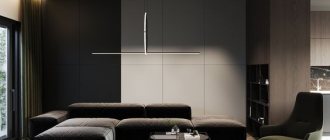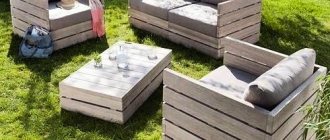The Soviet Union is a truly epoch-making state. During the history of its existence, this country had to go through several rounds of development, each of which was significantly different from one another. Moreover, the changes affected not only the state itself and the geopolitical ambitions and plans of its leadership, but also ordinary Soviet citizens. And all because the main person in that distant power, the General Secretary of the CPSU Central Committee, single-handedly made many decisions that very often had a direct bearing on the everyday life of ordinary people. In today’s article we will look at the conditions in which the citizens of the Soviet Union lived, or rather, let us remember the furnishings of their apartments and houses, first of all, the famous Soviet walls.
Examples of furniture from the Soviet era are still easy to find in typical Khrushchev and “Czech” buildings. Often these are products produced in the last years of the existence of the state, whose name is the USSR. This country has been gone for a quarter of a century, but it turned out to be an excellent manufacturer of furniture that still serves people today, like, in fact, many other things of that time.
Historical excursion
In the first years of the formation of the Union, the councils hardly thought about the conditions of the homes of workers and peasants. Those decades after the revolution were difficult for everyone, people had to use the furniture that they already had. At that time, even in the future, there was no such thing as “Soviet walls.”
All production capacities were aimed at establishing the state as such, and then at meeting the needs of the front. During these years, the main furniture producers in the country were wood processing plants and factories, sawmills, and small cooperatives where interior items were made by hand. The furnishings of rich houses of that time were distinguished by pretentiousness and pomp; it supported the canons of the pre-revolutionary years. Wardrobes, sideboards, chests of drawers and dressing tables were solid, massive, they were made of wood, often valuable species, and decorated with beautiful carvings and paintings. Few could afford this, and therefore these examples of furniture from the Soviet era are now the most valuable.
Ordinary people were content with rather rough cabinets and cabinets, cobbled together from what was at hand. There could be no talk of any aesthetics or luxury then.
Ten years after the end of the Great Patriotic War, the party decided that it was necessary to abandon excesses in construction. This provision also concerned the personal space of citizens, and therefore the interior furnishings of their homes.
Grandma's "antiques"
The population of the country at that distant time was placed in rather harsh living conditions. At that time, a massive migration of people from villages to cities began, including the capital of the Union. They had to live in communal apartments, dormitories or separate rooms, which were allocated by the townspeople for “limits” in order to generate additional income.
The cramped conditions forced many to get rid of the massive furnishings that cluttered their living spaces, and therefore high-quality and beautiful furniture, as well as sets that survived the revolution and were inherited by people, were mercilessly thrown away.
Those for whom the square meters allowed them to preserve antique furniture did not make a mistake, because it later became the envy of many, especially in conditions of the inaccessibility of modern analogues at that time. Soviet walls were a scarce commodity, a priority for many on the list of necessary purchases. People queued up for them, and families spent a long time saving money for new sets and sofas.
Not just apartments
At that time, there was no mass production of goods from the category of consumer goods, which included cabinets, walls, sideboards, dining sets, sofas and armchairs. However, the above-mentioned ruling changed the existing order of things. The government decided that it was necessary to provide the population with simple and affordable furniture.
This happened at a time when mass resettlement of people into separate apartments began. A lot of houses were built then, but the quality of the apartments in them left much to be desired. However, small, often adjacent rooms with low ceilings were still the ultimate dream for many.
Soviet furniture of that time was quite interesting. Factories have abandoned the use of natural wood for its manufacture, replacing this material with fiberboard and MDF. Designers then offered consumers products in the style of minimalism. If we describe the first Soviet walls, they can be characterized as small modules that consisted of two or three sections.
His Worship
And finally, the most important item of Soviet interior design is a luxurious carpet. There was probably no apartment in the USSR without a fleecy attribute, a symbol of prosperity and wealth. Buying a carpet has always been an event. They were given as gifts for weddings, anniversaries, and as dowries to brides.
By the way, thick carpets on the walls of Soviet apartments played not only a decorative role. The walls of the parents' "Khrushchev" and "Brezhnevka" buildings were and remain very thin, and the fluffy carpet on the wall became a kind of insulation and soundproofing material.
But the brother of His Worship is a tapestry with deer or bears. Due to the thinness of the material, it was not suitable for insulation, but as a decorative element it was found very often, probably in every second apartment. Sometimes a tapestry with deer was also used as a bedspread to cover a bed or ottoman.
An unjustly forgotten past
One such set contained a small wardrobe with hangers and shelves, closed with hinged doors, several open shelves or niches, and a glazed sideboard. The structure was installed on simple legs; most often they had a somewhat futuristic round shape and were located at an angle. Some models were supplemented with square mezzanines.
The walls of Soviet times, namely the 50-60s, had a laconic color, they were several shades of brown, imitating natural wood (walnut, ash, oak). It was then that varnish coating came into fashion. True, the first examples of such living room sets were of good quality. The gloss on many of them has not cracked to this day, even after half a century.
A typical Soviet wall (varnished), in accordance with its minimalist style, was equipped with laconic fittings. Its facades were smooth - no carving or relief. The handles were also distinguished by restraint; they were either in the form of narrow brackets made of metal, or were voluminous washers made of black or white plastic.
The latest Soviet furniture
Unfortunately, this design was abandoned quite quickly. Moreover, the choice was made towards even worse furniture options. In 1962, a special bureau was created to develop furniture, which has the status of an all-Union design institute. The work of its employees was greatly complicated by the state bureaucracy and nomenklatura. Having formed a project of a good design, the designer had to remake it to fit existing parts and materials that were currently in the state.
Starting from the 80s, one could already forget about the notorious high quality of Soviet furniture, as, in fact, about its normal appearance. It is these Soviet-made walls that have largely survived to our times. These are the notorious “Albina”, “Prostor”, “Domino”, “Orpheus” and other sets produced by Odessa, Zaporozhye, Zhitomir furniture factories.
The description of these “masterpieces of design thought” is very colorful. Among the samples there were also models with quite suitable appearance, mainly if their creators managed to do without excessive varnishing and decoration. However, it was mainly the decorations that spoiled the facades of cabinets, cabinets and mezzanines. Often it was a stucco stylization made of thin plastic. The ornate pattern was also supported in the door handles, which were lavishly decorated with monograms and sometimes with gilding.
The Soviet wall of the 80s is a very massive structure, which was usually placed along the longest wall in the room, most often in the living room. The standard equipment included tall modules for various purposes. For example, one such vertical line could consist of a lower cabinet, on top of which a glass sideboard was installed, and a mezzanine, located right under the ceiling, crowned the cabinet. The wall was formed from 3-5 such structures. Among them were narrow pencil cases, which theoretically should have had a bar, but people put everything they could get their hands on in this compartment.
The depth of cabinets of this period caused a lot of criticism from consumers, because they often did not even fit standard hangers.
From “homemade” to mass stamping
The main furniture producers in the Soviet Union are state-owned enterprises. They were located mostly in the European part of the country (in the territory of present-day Russia, Ukraine, Belarus). The plants were grouped near the largest cities in terms of population, such as Moscow, Leningrad, Kyiv, Kharkov. Each set had a factory name, but among the people furniture walls received a different name related to the place where they were made: wall “Zhytomyr”, “Odessa”, “Moscow”, “Yugoslav”, “Czech”.
Large enterprises made prefabricated furniture, which was sold in packaged form, while the owner independently assembled his “constructor”. It is worth noting that the development of the sets was carried out taking into account typical calculations of residential premises, and the wall itself had to fit into the room as harmoniously as possible.
Those who had such an opportunity purchased products created according to individual orders, obtained antique furniture, or restored what they inherited from wealthy ancestors.
Pros and cons of do-it-yourself restoration
Do-it-yourself restoration has both advantages and pitfalls. The advantages include the following points:
- Saving. Restoration or reupholstery carried out on your own will cost 3-5 times less money than professional renovation of furniture in a workshop.
- No additional risks. You don't have to transport furniture or disassemble and reassemble it for transport. Moving from place to place has a detrimental effect on old things; At the same time, there is a risk of dropping something and completely ruining it.
- No additional costs. Transportation and loader services (when the house does not have an elevator) can significantly increase costs if you do the delivery yourself.
In order to polish up an antique chest of drawers or a cabinet, you need to be prepared for the following disadvantages of working independently:
- You will need to organize a place. Restoration is accompanied by noise, dust and pungent odors. The old layer of paint or varnish is removed in two ways: by sanding (dust is formed) or using a solvent. The room is organized so that it is easy to ventilate and tidy.
- Have time and patience. This is not a one-weekend activity. Depending on the complexity, the repair may take several weeks, and it will have to be done in the evenings after work. It will also take time to select and buy materials.
- Possession of the necessary skills. Some jobs require professional flair. Using a sanding machine you can either delicately correct a figured leg, or ruin it irrevocably.
"Our" import
Sometimes imported walls went on sale. Moreover, these were even those products that came from very close foreign countries - the GDR, Yugoslavia. Getting and buying such furniture was the ultimate dream of any home owner. It served as an ideal reason for the owners to be proud and show off to guests, relatives and neighbors.
It is worth noting that such Soviet walls looked most advantageous in the interior. In addition, their quality was a level higher than that of products from factories of their own production located on the territory of the USSR, especially if we take into account the furniture manufactured immediately before the collapse of the Union.
Those who were lucky enough to travel abroad during the era of total denial of harmful capitalism note that Soviet walls and upholstered furniture made during the “Thaw” were in many ways similar to the then popular interior furnishings in the West, and these goods were no worse in quality imported. By the way, furniture in minimalist design, common in our country in the 50-70s, was the prototype of goods from the Swedish Ikea, which had already begun operating in Europe.
A look from a different angle - how to create a new interior with old furniture
Is it possible to save large cabinet furniture from the Soviet heritage and create an exclusive interior to your liking? Let's show 4 examples in which this desire is realized.
Example 1. Scandinavian living room
Massive wood-colored furniture will be an excellent dominant feature in such an interior. The main thing is that the furniture comes with an abundance of light and space.
Therefore, even old objects, dark, bulky and primitive in appearance, can be left unchanged.
Move the patterned oriental rug from the wall to the floor and be sure to save it, and decorate the walls themselves in white, light blue or a special “Scandinavian white” tone (white mixed with yellow and gray). Plus, you can add bright pillows to the interior to match the style of the carpet, old sets in the shape of fish, and be sure to “let in” natural diffused light (get rid of old curtains and dark lampshades).
2. Bedroom in Provence style
The basis for creating a style is furniture with smooth, thin legs, natural or lightened, which does not clutter the interior and is a little reminiscent of cozy country life. Complete the decor with simple country-style textiles, and make the basic color scheme light and monochromatic.
Shades of Provence that soothe the eyes - blue, pistachio, beige.
3. Oasis in retro colors
To create such an environment, only beautiful, rare sets can be used. But the color scheme of the interior should be refreshed. In a retro interior, white-gray and brightly colored objects (in particular, red) look interesting.
4. Cottage in European country style
In the interior of a country dacha, favorite items from the Soviet past always look beautiful - linen tablecloths and century-old wooden furniture. However, old furniture can be visually made expensive and rare - with the help of professional painting, patination, and decoupage.
As you can see, in cases where massive furniture is used, it is better for the wall decoration to be simple, light, and non-marking.
Interior miracle
It is not so difficult to find furniture from the times of the USSR now. It is especially common in apartments where elderly people live. Young people for the most part are trying to get rid of this “miracle” that smells like mothballs. It’s rare that a wall still looks tolerable, much less has managed to survive in its original form.
In the vastness of thematic design forums, you can often find a call for help from those who happened to become the “lucky” owner of a bulky Soviet wall. People are mainly interested in how to fit it into the interior as competently as possible. Experts advise, first of all, to get rid of stereotypical thinking and not to display the headset as a “wall”, distributing the modules in the corners, or even partially getting rid of them. First of all, this applies to sideboards filled with crystal and obsolete sets.
Practical use of mini-walls
Mini-walls, which have become increasingly popular recently, can be equipped with a number of design features.
Based on these differences, mini-walls are divided into the following classes.
- For installation of TVs, home theaters, music centers, displays for computer games. In this case, many glass shelves are used, deep niches are provided for speakers, wires, amplifiers and mixers.
- Transformer-type walls are especially good for small living rooms. They effectively save scarce space because they do not contain folding tables, bars, sections for crystal and glass glasses.
- Corner models are perfectly suited for receiving guests and organizing a feast; they also create comfortable conditions for reading magazines and drinking tea.
Modular structures consisting of floor and wall blocks, most often autonomous. These options are also very convenient for small rooms.
Change cannot be thrown away
Of course, good furniture now costs a lot of money, not everyone can afford to buy it, and therefore many have to put up with the proximity of their grandmother’s walls. But these are not always headsets of poor quality, with ill-conceived functionality and sagging doors. People who took care of their furniture, repaired it in a timely manner, preserved it and still enjoy using these cabinets and cabinets to this day.
In addition, if you are lucky enough to become the owner of a wall in the style of minimalism, art deco, or even the “Stalinist Empire” style, which was produced before the 80s, then after restoration it will be able to serve for more than a dozen years, but in appearance it will be difficult to distinguish it from modern imported furniture.
Implementation of classic style in the living room interior
Classic style will never lose popularity. He is timeless. Even the name of this design trend has become a household word and denotes consistency and relevance. But to create such a style, you need to follow all the rules. Not only of a technical nature, but also of a stylistic nature. Because it’s very easy to get carried away by mixing different eras and end up with a different style.
Second Life
Of course, then readers may have a completely reasonable question about how to update the old Soviet wall. It all depends on how well the furniture is preserved, the condition of its fittings, and also what it is made of.
If, by and large, everything is fine with it, and only the cabinet facades require restoration, then you need to use your imagination and work on creating a new appearance for already boring furniture. There are special organizations that carry out similar work; their designers share the secrets of their work and tell us in what areas you can work:
- rearrangement;
- color change;
- decor
All of these steps can be performed individually or together. Then you will certainly get completely different furniture. The decor of the Soviet wall is done by changing the fittings. Sometimes it is enough to change the door handles in the closet, and this completely changes its appearance. You can also work more radically by changing the style of the facades. Textiles, stones, and paints for painting are used as auxiliary materials.
Table-book
Another iconic piece of furniture of the USSR, designed specifically for small-sized Soviet apartments, is the book-table. As a rule, he stood modestly in some corner of the living room and appeared on the main stage only on holidays. When opened, the book-table occupied almost the entire free space of the small living room, but the whole family could easily fit behind it. And when folded, it saved a lot of space.
I must say that it still remains relevant today. Any modern furniture catalog necessarily has a section “transformable tables” with the very books that faithfully served as parents. More modern, made from different materials, but just as comfortable.
Reboot
A complete refurbishment of the old Soviet wall is a complex and painstaking task that requires more than one day of work. Before getting started, it is important to fully think through the placement of the furniture after restoration, as well as its style. The set can be remade so that only the frame will remain as before, and all other parts will be completely or partially replaced and updated.
Rotating mechanisms and fittings are subject to priority repair - pipes for hangers, hooks, hinges on door handles, guides in drawers, which in Soviet walls were made of either plastic or wooden slats, and therefore the cells simply collapsed on top of each other after several years of use .
The next step may be to eliminate other possible flaws - puttying holes, cracks and other defects. However, if you plan to paint the furniture a new color, you need to remove its top coat, especially if it is a varnished product. They are usually painted with nitro enamel over a previously primed surface.
The placement of the wall itself plays an important role. The disadvantage of such furniture is that there are picturesquely huge gaps between the cabinets, this greatly spoils its appearance. This can be avoided by bolting the sections together at the top.











